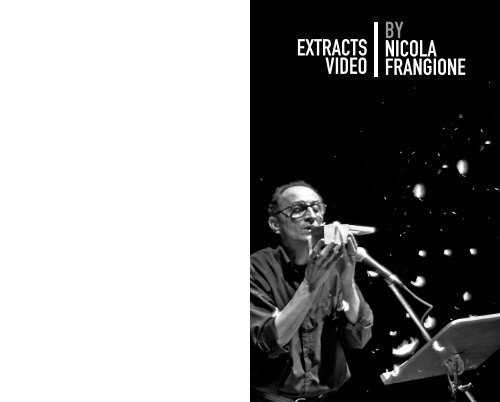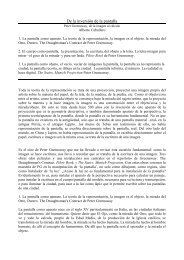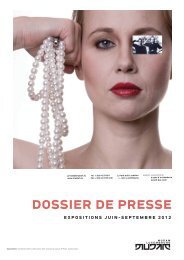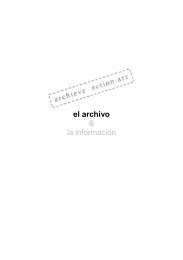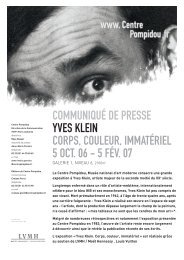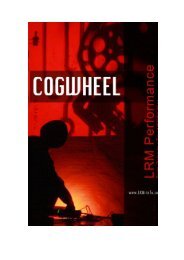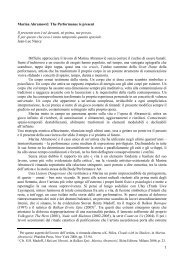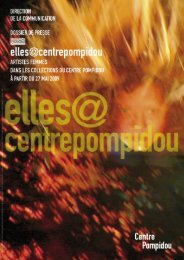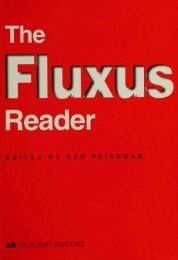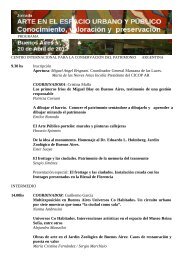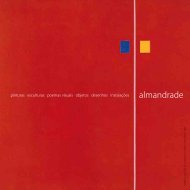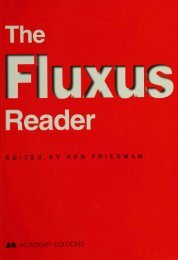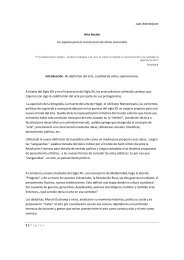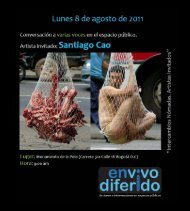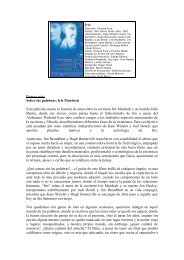EXTRACTS VIDEO BY NICOLA FRANGIONE - Geifco.org
EXTRACTS VIDEO BY NICOLA FRANGIONE - Geifco.org
EXTRACTS VIDEO BY NICOLA FRANGIONE - Geifco.org
You also want an ePaper? Increase the reach of your titles
YUMPU automatically turns print PDFs into web optimized ePapers that Google loves.
<strong>EXTRACTS</strong><br />
<strong>VIDEO</strong><br />
<strong>BY</strong><br />
<strong>NICOLA</strong><br />
<strong>FRANGIONE</strong>
<strong>EXTRACTS</strong><br />
<strong>VIDEO</strong> ACTION &<br />
<strong>VIDEO</strong> POETRY<br />
N I C O L A F R A N G I O N E<br />
1<br />
Video Poetry 2010 - Liquidity -<br />
“Aprendo la porta alle parole”<br />
testi- voce- video di Nicola Frangione,<br />
Music e Sound di Luca Frangione<br />
minuti - 10’07’’<br />
2<br />
Action Poetry - 2008 - “Voice in Movement”<br />
(vocecevovoce)<br />
testi-voce- video di Nicola Frangione,<br />
Music e Sound di Luca Frangione e Hermann Molteni<br />
minuti - 10’14’’<br />
3<br />
Video Poetry – 2007 - “Incorporalità”<br />
(speech dans le corps)<br />
testi e video di Nicola Frangione –<br />
Voce di Nicola Frangione e Massimo Arrigoni<br />
minuti - 5’38’’<br />
4<br />
Action Poetry – 2006 - “Reflection”<br />
(performance art as utopia concreta)<br />
testi e action di Nicola Frangione<br />
minuti - 3’08’’<br />
5<br />
<strong>VIDEO</strong> POETRY - 2000-2003<br />
“Voice in Movements”<br />
Compilation (oralità e trasversalità sonore)<br />
“Nembo verso Nord”- 4’17’’<br />
“Ittoosang” – 4’15’’<br />
“Pin-occhio al ticket” – 2’00’’<br />
“Vocecevovoce” – 5’49’’<br />
“Bassa Marea” – 4’19’’<br />
“Giallo Notturno” – 3’26’’<br />
6<br />
Performance Art – 1987 -<br />
“Fasti Poiesis” (Italic Environments)<br />
Action e Video di Nicola Frangione<br />
Testi di Michel Leiris<br />
Music e Sound di Riccardo Sinigaglia<br />
minuti - 11’03’’
IL GESTO DELLA<br />
PAROLA<br />
E LA<br />
PERFORMANCE<br />
DELLA VOCE<br />
N I C O L A F R A N G I O N E<br />
La riscoperta del valore del corpo nella voce non è nuova ma mi permette di considerare da un punto<br />
di vista emozionale ed espressivo la nuova Performance/Poetica, ed anche l’evoluzione di essa nella mentalità<br />
contemporanea, nell’ottica dell’integrazione dei linguaggi e della comunicazione artistica.<br />
Da molte parti non si dà spazio a queste ricchezze umane se non nella loro spettacolarizzazione: ma<br />
esse si infiltrano un po’ dappertutto, attraverso l’animazione di gruppi dinamici e l’attivazione di laboratori<br />
(performances, teatro, danza) per giungere ai più recenti esperimenti di terapia con l’arte, in forma di monologhi<br />
e performances innestate sull’analisi della conoscenza di sé e del sé.<br />
È grazie a questo bagaglio di approfondimenti teorici, di esperienze estetiche e di laboratori di produzione<br />
che si configura la mia ricerca artistica: essa viene considerata vuoi come arte totale, vuoi come<br />
poesia sonora, poesia fonetica, Action Poetry, Performance-Art.<br />
Negli ultimi quarant’anni, grazie al lavoro personale o coordinato con quello di molti artisti a livello<br />
internazionale, hanno visto a luce e si sono sviluppate intense performances e monologhi di Action-Voice,<br />
funzionali alla conoscenza e allo sviluppo di essa: provenienti da differenti realtà geografiche, questi lavori<br />
sono state accolti e rappresentati in diversi Festival Internazionali di nuova drammaturgia, visualità, sonorità<br />
e pensiero in movimento.<br />
Questo meccanismo costituisce per me una continua e progressiva presa di coscienza, non tanto il<br />
frutto di una strategia studiata. Dal 1973 gli eventi che promuovo e <strong>org</strong>anizzo nel contesto di manifestazioni<br />
artistiche interdisciplinari o al Festival Art Action di Monza o in altre iniziative e spettacoli sparsi in tutto<br />
il mondo nell’ambito della mia attività, hanno condotto ad una crescente valorizzazione della performanceart<br />
e ad un sempre più <strong>org</strong>anico e attento apprezzamento dei suoi sviluppi.<br />
È nella comunicazione interpersonale che si evidenziano in primo luogo le valenze della corporeità e<br />
della voce. Più la si sperimenta, più queste sono apprezzate nel loro portato di novità e pregnanza.<br />
Non si pretende di spiegare o giustificare ogni cosa con la sola ragione interpretativa. Occorre lasciar<br />
spazio anche all’immaginazione, al differente e al mistero. Il pubblico sa riconoscere l’importanza di un<br />
approccio esistenziale, percepisce l’energia trasferita e apprezza anche le dosi di imprevisto e di spontaneità<br />
poetica. È su queste premesse che nelle mie performances i testi vocali si possono tagliare, cucire, spostare,<br />
rendendosi disponibili a differenti significati come vera e propria costruzione musicale. Non si tratta tanto<br />
di testi cantati sulla musica, ma di testi come musica significante; una sorta di testi decontestualizzati,<br />
dunque, in sinergia con vari contesti di spazio espressivo, che accolgono e integrano il visuale, il visivo e<br />
il sonoro in un unico con-testo.<br />
Mai come gli ultimi decenni ci hanno fatto prender coscienza dell’immenso ritardo nello sviluppo e<br />
nell’integrazione del CorpoVoce. Arte e psicologia hanno un ruolo indispensabile, sia per la comprensione<br />
sia per lo sviluppo della personalità nella sua interezza. Non si può ignorare il corpo, coscienza di sé e del<br />
nostro spazio totale: ma questo si può ottenere solo attraverso la riscoperta del proprio CorpoVoce e della<br />
propria gestualità.<br />
Riappropriandomi del CorpoVoce e di tutte quelle realtà che in esso hanno radice, dentro il sé e fuori<br />
del sé riconquisto le emozioni, i sentimenti, le intuizioni, la spontaneità. Come nel parto, la donna, riappropriandosi<br />
del corpo, porta a buon fine la sua gravidanza, così, per spontanea similitudine, il CorpoVoce<br />
è inteso come un tutto dinamico e vitale.<br />
Noi siamo come un sismografo sensibile: il nostro <strong>org</strong>anismo può registrare uno stato di tensione che<br />
a volte esalta e a volte inceppa le sue funzioni essenziali di <strong>org</strong>ano motore e strumento per la comunicazione<br />
interpersonale. Si tratta di passare dal sistema dell’avere a quello dell’essere, dal corpo oggetto al corpo<br />
vissuto, dallo stupefacente apparire allo stupefacente essere.<br />
Nel corpo che parla noi riusciamo ad allentare il dominio della logica discorsiva e astratta, ci acc<strong>org</strong>iamo<br />
che anche la voce ha un proprio modo di pensare. E nelle performance non è mai obbiettivo come una macchina,<br />
per quanto sofisticata: è il luogo dove risuona con il corpo nella totalità. È nel proprio corpo e attraverso<br />
di esso che l’essere percepisce il reale. È a partire dal corpo che con la voce si stabilisce il<br />
linguaggio primordiale, dividendo il tempo e lo spazio. Da qui la sonorità nasce, vive e si espande: in alto,<br />
in basso, in avanti, indietro, a sinistra, a destra, prima, durante e anche dopo la performance.<br />
Il CorpoVoce in movimento fonda in certo modo pensiero e linguaggio. Per muovere ed evidenziare la<br />
ricchezza del gesto e il suo ruolo fondatore di lingua originaria. Il pensiero nel gesto della voce non ha idee<br />
pure: ogni coscienza è gestuale, ogni giudizio è interazione.<br />
Nell’essere, l’intelletto agisce attraverso i sensi, la realtà colpisce il suo corpo ed egli interviene sulla<br />
realtà segnandola con la forza espressiva dell’intero suo essere.<br />
Ciascuna fase di ogni interazione è sempre fremente dell’una o dell’altra di quelle innumerevoli irradiazioni<br />
affettive che a giusto titolo vengono chiamate emozioni o “mozioni” emergenti dal profondo.<br />
Ascoltare il proprio corpo o quello degli altri accompagna l’essere nel suo desiderio di capire e costruire<br />
legami della comunicazione. Le esperienze del corpo sono sempre coinvolte in una comunicazione interpersonale<br />
anche quando sono negate o costrette.<br />
La nostra voce investe il corpo con il carattere testuale del vissuto un attimo dopo e dimostra che sta<br />
cambiando la percezione stessa del suo ruolo: non è facile prevedere se questi elementi di evoluzione sfuggiranno<br />
a un tentativo di recupero nel percorso di crescita individualmente collettiva, verso una maggiore<br />
creatività e autonomia poetica, in una prospettiva di apertura agli altri. Occorre stare accorti.<br />
Nicola Frangione<br />
Monza – gennaio 2010
<strong>VIDEO</strong>ARTE<br />
<strong>VIDEO</strong>INSTALLAZIONI<br />
<strong>VIDEO</strong>POESIA<br />
<strong>VIDEO</strong>PERFORMANCES<br />
1984<br />
Regia video di "Spettacolazioni<br />
di musica e immagini” del musicista V. Zitello.<br />
Regia video di "Dalla musica ancestrale alla musica<br />
elettronica" del musicista Mario de Leo.<br />
Regia video di "Concreti<br />
affioramenti mentali" dell'artista Emilio Morandi.<br />
Regia video di "Una quercia<br />
in giardino" del musicista Franco Ballabeni.<br />
Partecipa al video "BLA ABNER"<br />
di Steen M.Rasmussen. ed.Plagiat, DANIMARCA.<br />
Organizza la rassegna di Video-Art alla Biblioteca<br />
Civica, Comune di Sesto S. Giovanni.<br />
1985<br />
Partecipa alla Rassegna FILM-MAKER,<br />
video di nuovi autori, MILANO.<br />
Cura la trasmissione televisiva "Audio-video-art"<br />
per l'emittente <strong>VIDEO</strong>BRIANZA.<br />
Regia video di "Percorsi attraverso percorsi"<br />
performance di N.Frangione U-matic.<br />
Rassegna Internazionale di Video-Arte U-TAPE,<br />
Centro Video Arte di FERRARA.<br />
Tokyo Video Festival, sezione artistica,<br />
Tokyo, GIAPPONE.<br />
Rassegna Video Art International, Stoccolma, SVEZIA.<br />
H A PA RT E C I PATO C O N<br />
1986<br />
Rassegna Internacional Video Art CMU Chaminade,<br />
CFD Madrid, SPAGNA.<br />
"Elektronpoiesis" Rassegna Internazionale<br />
di video-poesia, Comune di FROSINONE.<br />
Regia del video "Attoinform"dell'artista Flavio<br />
Piras,durata 12 minuti.<br />
Regia del video "Ritmi Estatici" dell'artista Mario<br />
de Leo, durata 7 minuti.<br />
"Rassegna di Video-Art U-TAPE, Centro Video Arte<br />
di FERRARA.<br />
1987<br />
Regia del video "Fasti Poiesis" U-matic,<br />
performance di N. Frangione, durata 10 minuti.<br />
Regia del video "Nel Modo amodale"<br />
poeta Luigi Bianco, durata 32 minuti.<br />
Rassegna Video-Art "D'art Room"<br />
Avanguardia Europea, Comune di BOLOGNA.<br />
2° Mostra Internazionale Video, Casa Municipal<br />
de Cultura, Puertollano, SPAGNA.<br />
Regia del video "Marra" per l’artista Max Marra,<br />
durata 5 minuti.<br />
Organizza la Rassegna Nazionale di <strong>VIDEO</strong>ART,<br />
Galleria Civica,Comune di MONZA.<br />
Rassegna international AVE 87, audiovisuell festival,<br />
Arnhem, OLANDA.<br />
1988<br />
Rassegna Videomaker,Cineteca Italia,<br />
Museo del cinema, MILANO.<br />
Organizza la rassegna video-art al<br />
Comune di Ponte Nossa, BERGAMO.<br />
Organizza la rassegna video-art al<br />
Comune di Clusone, BERGAMO.<br />
Rassegna di video-art U-TAPE,<br />
Centro Video Arte di FERRARA.<br />
1989<br />
Rassegna Internazionale di computer e video-art<br />
(1°premio videoarte) Barcellona.<br />
Rassegna Internazionale AVE 88, audiovisuell<br />
festival, Arnhem, OLANDA.<br />
Selezione di artisti video per la rivista<br />
D'ARS, MILANO.<br />
1990<br />
Rassegna "The Vision Vortex" Glastonbury,<br />
London, INGHILTERRA.<br />
International Video Festival - VRO 90,<br />
Wroclaw, POLONIA.<br />
1991<br />
Regia del video "Matath" performance<br />
di N.Frangione, durata 6 minuti.<br />
Videoinstallazione "COMERSON" salone EXPOSTE,<br />
Comune di MONZA.<br />
Organizza la Rassegna di Video-Art a:<br />
Villa Asquer, Comune di Cagliari.<br />
Comune di Bulciago, Como.<br />
Comune di Girifalco, Catanzaro.<br />
1992<br />
Rassegna video-art, Galleria Diade, BERGAMO.<br />
OXFORD INDIPENDENT <strong>VIDEO</strong> Pegasus Theatre<br />
Oxford, INGHILTERRA.<br />
Organizza rassegna internazionale-video<br />
per "INTERAZIONI 5", CAGLIARI.<br />
1993<br />
Installazione video per la rassegna ITINERART,<br />
Arengario di Piazza Duomo, MILANO.<br />
Rassegna Mediale Videoforum, Buz, Minden.<br />
GERMANIA.<br />
Rassegna MONITOR 93 , Frolunda Kulturhus<br />
Gothenburg Art Museum, SVEZIA.<br />
1994<br />
Partecipa al programma televisivo arte<br />
e tecnologia "Cyberia", su TELE+3.<br />
Partecipa al programma televisivo "Art Media"<br />
Antenna 2, FRANCIA.<br />
Edizione CD-ROM Project NTT-Intercommunication<br />
Center, Tokyo, GIAPPONE.<br />
1995<br />
Rassegna Video-"New Kapolcs Gallery" e Art Pool<br />
Center, Budapest, UNGHERIA.<br />
"FIV-95" Festival Internacional de Video<br />
y Artes Electronicas, Buenos Aires, ARGENTINA.<br />
1996<br />
Edizione CD-ROM Project Collection Networking,<br />
TAC by Guy Bleus, BELGIO.<br />
1997<br />
Edizione CD-ROM Project Eutopia Mail Art<br />
from the West , Limburg TAC, OLANDA.<br />
Organizza la Rassegna di <strong>VIDEO</strong>ARTE<br />
al Castello di Magliano Alfieri, ALBA.<br />
edizione CD-ROOM Project Akenaton-DOC(K)S,<br />
Ajaccio FRANCIA.<br />
1998<br />
Realizza e pubblica l'edizione in videocassetta<br />
4-30 1-98 edizioni HARTA PERFORMING<br />
commonpress sulla drammaturgia e performance<br />
arts italiana<br />
Presenta rassegna di video-art Italiana<br />
Comune di Rosignano Marittimo, LIVORNO.<br />
Organizza Rassegna internazionale di video-arte<br />
Comune di Ferentino, FROSINONE.<br />
edizione "Bureaus 1001 desks" Centrum<br />
Beeldende, Groningen, OLANDA.<br />
edizione CD-ROM "Reinolds Recycling Center"<br />
Palazzo delle Esposizioni, ROMA.<br />
1999<br />
Videoinstallazione "Mulino Colombo"<br />
Assessorato alla Cultura, Comune di MONZA.<br />
edizione CD-ROM "Gezelle" di Poesia Visiva<br />
Culturcentrum, Brugge, BELGIO.<br />
edizione CD-ROM "The World of Artitamps"<br />
Western Canada, Ontario, CANADA.
2000<br />
Videoinstallazione al Chiostro Agostiniano,<br />
percorsi della memoria, Città di MONZA.<br />
2002<br />
“Contemporanea” Video Arte 6°<br />
Salone d’arte Moderna, FORLI.<br />
International Video Festival BENT-02<br />
Centre Contemporary Culture Barcelona, SPAGNA.<br />
2003<br />
4°International Video, Multimedial Art Festival,<br />
IMAF, Odzaci, SERBIA.<br />
Video Poetry, ”6 Partiture di Video Poesia”<br />
con Visual Factory, MONZA.<br />
2004<br />
Festival International “BARDO” Video Poesia,<br />
Buenos Aires, ARGENTINA.<br />
7° Festival Cine e Videopoesia, Museo<br />
di Buenos Aires, ARGENTINA.<br />
2005<br />
“IV Fiesta Poetica” de Videopoesia, Museo Caixa<br />
Forum, Barcelona. SPAGNA.<br />
“18°Les Instants Video” Ecole Supérieur d’Art,<br />
Aix-en-Provence, FRANCIA.<br />
VideoBardo-Instants, Centre Marcel Pagnol,<br />
Fos-Sur Mer, FRANCIA.<br />
Bardo-InstantsVideo, La Friche de la Belle de Mai,<br />
Marseille, FRANCIA.<br />
Video Poesia, Centre d’Art Contemporain,<br />
Hérouville Saint-Cler, FRANCIA.<br />
MNM – New Media Festival,<br />
Video Sala Maddalena, MONZA.<br />
VideoPoesia Estudio Abierto,<br />
Museo de los Inmigrantes, BS.ARGENTINA.<br />
Video Poesia al centro Cultural B<strong>org</strong>es,<br />
Buenos Aires, ARGENTINA.<br />
2006<br />
3°Zebra Poetry Film Award Literatur, Videobardo,<br />
Berlino, GERMANIA.<br />
II° Festival VideoPoesia, Espacio Giesso,<br />
Buenos Aires, ARGENTINA.<br />
3° Festival ZonadeArteAccion + VideoBardo,<br />
Buenos Aires, ARGENTINA.<br />
NIVAF International Video Art Festival, Nagano,<br />
Nagano, GIAPPONE.<br />
Video “Reflection”, Harta Performing, Monza.<br />
2007<br />
“Effetti Collaterali” video-exhibition, progetto<br />
XX.9.12 Fabrika, Spazioeventi Mondatori, VENEZIA.<br />
Video “Incorporalità” ( speech dans le corps),<br />
Harta Performing, Monza.<br />
2008<br />
Editions Intervention Video, Inter Art Actuel,<br />
Le Lieu,Québec City, CANADA.<br />
Rassegna di Videopoesia “Videopoetry Dream”<br />
Comune di CREMA.<br />
III° International Video Bardo-Poetry, Malba,<br />
de Literatura, Buenos Aires, ARGENTINA.<br />
Video “Voice in Movement” (vocecevovoce)<br />
Harta Performing, Monza.<br />
2009<br />
“VideoPoetry Dream” Circolo Poetico Correnti,<br />
Calisto Café, Vailate, CREMONA.<br />
“Lineainfinita & Multimediale -<br />
International Videoart, Ponte Nossa, BERGAMO.<br />
“KLANG” Suoni Contemporanei Rassegna,<br />
Audio-Video, Villa Paolina, VIAREGGIO.<br />
Videopoetry Dream, Installazioni di Videopoesia,<br />
Castelleone, CREMONA<br />
Finalista alla III° edizione internazionale di Video<br />
Poesia DOCtorCLIP,-ROMA-Poesia.<br />
TEN YEARS of IMAF Gallery 1998-2008 DVD<br />
catalogue, Odzaci, SERBIA.<br />
“Video Poetry Dream” Circolo Poetico Correnti<br />
Castelleone, CREMONA.<br />
2010<br />
Festival Video Art - Performance, AurOrartExpo,<br />
Auer-Ora, Bolzano.<br />
Internazionale di VideoPoesia “Poesia Presente”<br />
Bloom di Mezzago, Milano.<br />
Edizione VideoCollection, Extracts 1986-2010,<br />
Harta Performing, Monza.<br />
Rassegna “Correnti Nomadi” di Video Poesia,<br />
Circolo Poetico Correnti, CREMA.<br />
VideoPoetry “Liquidity” Aprendo la Porta alle Parole,<br />
edizioni Harta, Monza.<br />
Rassegna “Correnti Nomadi” di Video Poesia,<br />
Circolo Poetico Correnti, CREMA.<br />
Filba-VideoBardo, Festival Internacional<br />
de Literatura, Buenos Aires, ARGENTINA.<br />
RASSEGNE<br />
DI <strong>VIDEO</strong> ARTE<br />
INTERNAZIONALE<br />
ORGANIZZATE DA <strong>NICOLA</strong> <strong>FRANGIONE</strong><br />
Le rassegne <strong>org</strong>anizzate da Nicola Frangione con l’Associazione Culturale “Harta Performing” con opere<br />
di autori di fama internazionale. Di varia provenienza artistica e nazionalità, usano il video anche come<br />
mezzo specifico di espressione, in modi diversi e con diverse autonomie di linguaggio: video-teatro, videopoesia,<br />
computer-art, nuova-documentazione, video-performance, computer-animation, video Poesia.<br />
Harta Performing, dal 1973 ha posto l’attenzione su avvenimenti di artisticità sperimentale e di ricerca,<br />
progettazione e produzione: dalle arti figurative al teatro, attraverso la multimedialità e interdisciplinarietà.<br />
Nelle rassegne internazionali si sono tracciate alcune linee di demarcazione già da tempo esistenti ma<br />
tutte fondamentali per una conoscenza critica e di orientamento per una conoscenza più completa dei<br />
singoli percorsi artistici in un’epoca indirizzata verso una comunicazione più diretta e in sinergica.<br />
“La Video Art e Video Poesia come qualsiasi altra arte, ha davanti a sé il denominatore comune dell’immagine<br />
che tutti credono di tenere fermamente in pugno, ma essa è contemporaneamente in molti<br />
luoghi, sempre contaminata in un identico rapporto di spazio-tempo-luce.<br />
I video hanno dato spesso la sensazione che l’immagine, anche quando è esattamente riprodotta dalla<br />
macchina elettronica, talvolta si nasconda, diventi ambigua e sfuggente, anche se essa è velocissima ed è<br />
già andata molto lontana.<br />
Con le rassegne <strong>org</strong>anizzate sono state presentate e analizzate le comunicazioni estetiche-artistiche<br />
della tecnologia elettronica che ormai sarà presente quotidianamente, direttamente o indirettamente nella<br />
nostra vita.<br />
Come nell’espressione creativa il problema dell’arte è stato negli anni successivi modificata, con una<br />
forza poetica che con la video-arte ha semmai svuotato effetti di spettacolarità estetica. Ha creato anche<br />
un nuovo contenitore di elementi della memoria collettiva.<br />
Con le rassegne si sono sottolineate le videoproduzioni di artisti che hanno maggiore libertà, anche il<br />
video può ricominciare sempre da zero. Anche se esiste da molti anni è come se dovesse fare oggi la sua<br />
prima apparizione nella sala parto dell’arte. Oggi l’artista artigiano sa fare e raccontare, l’artista creatore<br />
sa vedere e dice. Ogni opera autentica deve essere due volte nuova, nuova come informazione poetica e<br />
nuova come caratteristica fisica, allo scopo di poter affrontare il tempo dell’esistenza umana, non verso lo<br />
stupefacente apparire ma indirizzata verso lo stupefacente essere.
HANNO PARTECIPATO<br />
E COLLABORATO A<br />
RASSEGNE E PROGETTI<br />
COLLETTIVI “<br />
HARTA PERFORMING”<br />
DAL 1984<br />
ARTISTI ITALIANI<br />
Felice Pesoli - Nicola Frangione -<br />
Lola Bonora - Vittorio Fagone -<br />
Maia Borelli - The Tape Connection Roma<br />
- Indigena Milano - Centro Video Arte Ferrara -<br />
Bang & Olufsen - Gi<strong>org</strong>io Cattani<br />
- Fabrizio Plessi - Luciano Mignani<br />
- Orazio Di Mauro - Enore Zaffiri -<br />
Maurizio Bonora - Maurizio Camerani -<br />
Gaetano Colonna - Piero A. Olmeda -<br />
Alberto Di Cintio - Piermario Ciani<br />
- Theo Eshetu - I Borborigmi<br />
- Caterina Borelli - Roberto Nanni<br />
- Vettori Ultramondo - Federico Tiezzi -<br />
Sandro Lombardi - Gianni Pini<br />
- Alfredo Pirri - Pierandrea Gagliardi<br />
- Claudio Zanini - Giuliano Bartoli<br />
- Correnti Magnetiche - Sergio Tinaglia<br />
- Mario Canali - Riccardo Sinigaglia<br />
- Studio Azzurro - Emilio Morandi<br />
- Paolo Rosa - Susanna Pavanello<br />
- Fabio Cirifino - Leonardo Sangi<strong>org</strong>i<br />
- Parco Butterfly - Bruno Zanzottera -<br />
Adriano Accattino - Massimo Arrigoni<br />
- Vittore Baroni - Alessandro Benfenati<br />
- Luigi Bianco - Davide Bramante<br />
- Pietro Brunelli - Daniela Bruni - Irene Cinus<br />
- Camillo Cuneo - Giovanni Fontana -<br />
Marcello Diotallevi – Alberto Casiraghi<br />
– Mauro Dal Fior – Caterina Davinio<br />
- Gabriele Grotto - Ignazio Lago<br />
- Claudio Maccagno - Ruggero Maggi -<br />
Gianni Mangione - Giovanni Morbin -<br />
ARTISTI<br />
INTERNAZIONALI<br />
E CENTRI OPERATIVI:<br />
Pierangelo Pandiscia - Anna Maria Pugliese -<br />
Gian Paolo Roffi - Roberto Rossini -<br />
Carlo Stéphanos - Massimo Zanasi<br />
– Daniela Zebra - Michela Montrasio<br />
– Gi<strong>org</strong>io Fabbris – Luisa Sax<br />
– Luca Privitera - Antonello Cassinotti<br />
– Bruno Larini - Giuliano Zosi - Elena Chiesa<br />
– Caterina Moroni & Lucio Mattioli,<br />
– Angelo Pretolani – Gruppo Sinestretico<br />
– Beniamino Vizzini – Angela Belmondo<br />
– Tomaso Binga – Massimo Mori<br />
– Gian Paolo Guerini – Paolo Albani<br />
– Cristina Negro – Tino Schepis<br />
– Ariella Vidach.<br />
ARTISTI STRANIERI<br />
Bartolomé Ferrando (Spagna) – Gertrude<br />
Moser-Wagner (Austria) – Philippe Castellin & Jean<br />
Torregrosa (Francia) – Valentine Verhaeghe & Michel<br />
Collet (Francia) – Uto Gusztav (Romania)<br />
– Mari Novotny Jones (USA) – Julien Blain (Francia)<br />
– Marilyn Arsem (USA) –<br />
Waldemar Tatarczuk (Polonia)<br />
– Martin Zet (Rep.Ceca)<br />
– Marina Mars & Frédérique Guétat Liviani (Francia)<br />
– Jamie McMurry (USA) – John Giorno (USA)<br />
– Joao Samoes (Portogallo) – Artur Tajber (Polonia)<br />
– Adachi Tomomi (Giappone)<br />
– Sinéad O’Donnel (Ireland) - Sylvie Ferré (Francia) -<br />
Roger Bourke (UK) - Jocelyn Fiset (Canada)<br />
- Wladyslaw Kazmierczak (Polonia)<br />
- Ewa Rybska (Polonia) - Shalom Neuman (USA) -<br />
Olivier Garcin (Francia) - Seiji Schimoda (Giappone)<br />
- Tomasz Wendland (Polonia)<br />
- Nenad Bogdanovic (Serbia-Montenegro)<br />
- Katalin Ladik (Ungheria)<br />
- Angela e Peter Netmail (Germania)<br />
- Giuseppe De Giacomi e Niska (Svizzera)<br />
- M<strong>org</strong>an O’Hara (USA) - Xavier Sabater (Spagna)) -<br />
Endre Szkárosi (Ungheria) – Andre Stitt (UK)<br />
– Adina Bar-On (Israele) – Dan McKereghan (USA) –<br />
Nieves Correa (Spagna)<br />
– Demosthenes Agrafiotis (Grecia)<br />
– Roddy Hunter (UK) – Elvira Santamaria (México)<br />
– Richard Martel (Canada)<br />
– Richard Piegza (Polonia) - Hervé Brunaux (Francia)<br />
- Boris Nieslony (Germania)<br />
- Denis Romanovski (Bielorussia)<br />
- Ryszard Lugowski (Polonia)<br />
- Victor Petrov (Bielorussia)<br />
- John G. Boheme (Canada)<br />
- Jan Swidzinski (Polonia) - Helge Meyer (Germania)<br />
- Llewyn Maire (usa) - Lisa Newman (USA)<br />
- Anton Roca (Spagna) - Monika Gunther (Germania)<br />
- Ruedi Schill (Svizzera) - Gordian Piec (Polonia)<br />
- Stanislaw Piotr Gajda (Polonia)<br />
- Fabien Montmartin (Francia)<br />
- Jonas Stampe (Svezia) - Myriam Laplante (Canada)<br />
- Tomaso Kemeny (Ungheria)<br />
- Fernando Aguiar (Portogallo)<br />
- Anne-James Chaton (Francia)<br />
– Bàliant Szombathy (Ungheria)<br />
- Marie Bosque (Francia)<br />
- Jòzsef R. Juhàsz (Slovakia)<br />
- Marianela Leòn Ruiz (Spagna)<br />
- Zuzana Zabkovà (Slovakia)<br />
- Monica Klingler (Svizzera)<br />
- Adrian Shephard (UK) - Michael Northam (USA).
WORD EXPRESSION<br />
AND VOICE<br />
PERFORMANCE<br />
N I C O L A F R A N G I O N E<br />
The rediscovery of the value of the body in the voice is not so new, but it allows one to take into consideration,<br />
the emotional and expressive aspect of the new Performance/Poetical, together with the evolution of it as far as<br />
the contemporary way of thinking and the integration of languages and artistic communication is concerned. Not<br />
much space is given to this wealth of human potentiality, apart from it being transformed into a representation:<br />
however it is infiltrating little by little everywhere, through the animation of dynamic groups and the setting up of<br />
laboratories (performances, theatre, dance), not to mention the most recent experiments of therapy combined<br />
with art, in the form of monologues and performances based on the analysis of one’s self knowledge and of oneself.<br />
Thanks to this wealth of theoretical in depth studies, of aesthetic experiences and of productive laboratories<br />
which give shape to my artistic quest: it can be considered sometimes as being totally Art, or as sonorous poetry,<br />
phonetic poetry, Action poetry or Performance-Art.<br />
In the last 40 years, thanks to my own work together with the collaboration of many artists on an international<br />
level, intense performances and monologues of Action-Voice have been developed and carried out, with the aim<br />
of discovering and developing knowledge: deriving from different geographic realities. Moreover these works have<br />
been appreciated and represented in different International Festivals of new dramaturgy, visualization, sonority<br />
and thought in movement.<br />
This mechanism represents for me, a continuous and progressive awareness and not so much the result of<br />
a pre conceived strategy. Since 1973 the events which promote and <strong>org</strong>anize the field of interdisciplinary artistic<br />
performances concerning my activity, like at the Art Action Festival of Monza or in other initiatives and shows<br />
around the world; these have brought about a growing valorisation of performance-art and a systematic appreciation<br />
and more emphasis as far as its development is concerned. It is a kind of interpersonal communication which<br />
brings out first of all, the value of corporality and of the voice. The more one experiments, the more one can appreciate<br />
this, in that they bring in novelty and meaningfulness.<br />
One cannot expect to explain and justify everything with only one interpretation. It is necessary to let the<br />
imagination run wild, moving towards diversity and mystery. The public can recognise the importance of an existential<br />
approach, it can perceive the energy which is transferred and also appreciate the improvised turn of<br />
events and spontaneous poetry.<br />
It is based on this, that in my performances the vocal texts can be cut out, stitched on , moved around, making<br />
them more open to different meanings as if they were<br />
purely a musical creation. One is not speaking about pieces sung based on the music, but of pieces like eloquent<br />
music; a sort of de contextualized work, totally in synergy with the different contexts of meaningful space,<br />
which embrace and integrate the vision, the visual and the sonorous in one sole co-text.<br />
Never like in the last ten years, have we realised that there has been such a tremendous delay in the development<br />
and the integration of BodyVoice. Art and psychology have had such an indispensable role not only in the<br />
understanding, but also in the development of the personality in its entirety. One cannot ignore the body, one’s<br />
consciousness and our total space: but this can be obtained only through the re discovery of one’s BodyVoice and<br />
one’s gestural expressiveness.<br />
Repossession of Bodyvoice and all those realities which have roots in oneself, deep inside oneself and externally,<br />
one can then regain the emotions, the sentiments, the intuitions, the spontaneity. Like when giving birth,<br />
the woman, takes possession of her body and completes the cycle of pregnancy, by taking this as a spontaneous<br />
comparison, the Bodyvoice is interpreted as a dynamic and vital totality.<br />
We are like a sensitive seismograph: our <strong>org</strong>anism can manifest a state of tension which exalts and at times<br />
holds back essential functions which drive it and thus are essential tools for interpersonal communication. One<br />
is speaking about going from the system of “having” to the one of “being”, from the body as an object to the lived<br />
in body, from the stupefying mode of “appearing” to the stupefying mode of “being”.<br />
In the body which speaks, we are able to slow down the dominance of discursive and abstract logic , we<br />
realise that also the voice has its own way of thinking. And in the performance, it is never objective like a machine,<br />
however sophisticated it may be: it is the place where it resounds with the body in totality. It is in one’s body and<br />
through it that the being perceives the real.<br />
It is starting from the body, that together with the voice one establishes the primordial language, dividing<br />
time and space. From this the sonority is born, lives on and expands: to the top, to the bottom, in front, behind,<br />
to the left, to the right, first, during and after the performance.<br />
The BodyVoce in movement combines , thought and language modes in a certain way. In order to move and<br />
emphasise the richness of the gesture and its founding role of the primary language. Thought in the expression<br />
of the voice does not have pure ideas . Every conscience is gestural, every judgment is interaction.<br />
In the being, the intellect acts on the senses, the reality affects its body and it intervenes in the reality<br />
marking it with the expressive force of the totality of its being. Each phrase in every interaction is continuously<br />
vibrating from one to the other of those numerous emotional irradiations which are termed and called emotions<br />
or “motions” emerging from deep down. Listening to our body or the one of others help the being of our desire,<br />
to be able to understand and build bonds of communication. The experiences of the body are always involved in a<br />
kind of interpersonal communication, even when they are denied or forced.<br />
Our voice provides our body with a textual individuality of experience and shows that the perception of itself<br />
is changing : it is not easy to foresee if these elements of evolution will disappear in the attempt to recover the<br />
path individually collective growth, with a view to greater creativity and poetic autonomy and opening up towards<br />
others. We must be on our guard.<br />
Nicola Frangione<br />
Monza – January 2010
BREVE<br />
BIOGRAFIA<br />
N I C O L A F R A N G I O N E<br />
SCHORT<br />
BIOGRAPHY<br />
N I C O L A F R A N G I O N E<br />
Nicola Frangione è nato a Forenza PZ italy nel 1953.<br />
Vive e lavora a Monza dal 1972, artista interdisciplinare e sperimentatore di varie tecniche artistiche:<br />
arti visive, musica e poesia sonora, regia video e teatro, poesia visiva, performance art &Action Poetry.<br />
Oltre la ricerca poetica è stato uno dei più importanti performers e Mail-artisti internazionali, da circa<br />
35 anni contribuisce allo sviluppo e alla diffusione in italia <strong>org</strong>anizzando Festival, progetti, mostre e laboratori<br />
itineranti.<br />
Ha pubblicato e prodotto edizioni di libri-d’arte, libri-oggetto: Dal 1975 rivista di poesia “Armadio e<br />
Officina”.- 1977 il libro “Osservazioni critiche sulla funzione del nervo ottico nella semiotica dell’arte”.-<br />
1979 il libro “The relativity of language as the enigma of art”-. 1980 “Zen and Art” e “Snapshot”.- 1987<br />
“Madame et Theatre”-. Dal 1987 al 1995 ha diretto con Luigi Bianco la rivista di dinamiche culturali “Harta”<br />
e Osaon spazio artistico multimediale di Milano.- Dal 1996 direzione di coordinamento delle edizioni “Harta<br />
Performing” sulla performances arts italiana.<br />
La sua ricerca nel campo musicale e della Poesia-Sonora ha visto la pubblicazione di dischi e cd: 1983<br />
“Mail Music” l.p .- 1985 “Italic Environments” l.p. edizioni Armadio Officina, -1997 il cd “Radio Art”, - 1999<br />
il cd. “Rapporti orali e trasversalità sonore”. Suoi lavori sonori sono stati trasmessi da radio nazionali in:<br />
Olanda, Svezia, Spagna, USA, Giappone, Canada e da RAI uno e RAI tre in Italia.<br />
Come videoartista sui lavori sono stati trasmessi in rassegne e programmi televisivi dal 1985 al 1995:<br />
Film Maker di Milano. U-TAPE centro video di Ferrara. Video Festival di Tokio. Art video-festival di Stoccolma.<br />
CMU di Madrid. Festival Arnhem in Olanda. Tele+3 Italia ecc.<br />
Con performances e Reading Action Poetry partecipa a numerose rassegne e festival internazionali.<br />
Tra gli ultimi suoi lavori attualmente itineranti si segnala: “Percorsi attraverso percorsi”, “Italic Environments”,<br />
“Allitterazioni Sonore”, “Oralità e Trasversalità Sonore”. Dal 2002 è direttore artistico del festival<br />
Internazionale ART ACTION-Harta Performing. Con il Comune di Monza, Provincia di Milano, Provincia Monza<br />
e Brianza, Regione Lombardia e Commissione Europea.<br />
Nicola Frangione was born in Forenza (Potenza), Italy, in 1953. He has been living and working in Monza<br />
since 1972, as an interdisciplinary artist experimenting with several techniques: visual arts, audio art and<br />
sound poetry, video-art and visual poetry.<br />
He has published and produced several art books: the poetry magazine “Armadio e Officina” (since<br />
1975); the book “Osservazioni critiche sulla funzione del nervo ottico nella semiotica dell’arte” (1977); the<br />
book “The relativity of language as the enigma of art” (1979); “Zen and Art” and “Snapshot” (1980); “Madame<br />
et Theatre” (1987).<br />
From 1987 to 1995 he directed with LuigiBianco the publication of the cultural dynamics magazine<br />
“Harta” and managed the multimedia art centre,“Osaon”, Milan. Since 1996 he has been co-ordinating<br />
“edizioni Harta Performing”, concerning Performance Art and Action Poetry.<br />
Research on music and sound poetry has resulted in several records and CDs:“Mail Music”(LP, 1983);<br />
“ItalicEnvironments” (LP, 1985); “Radio Art” (CD, 1997); “Rapporti orali e trasversalità sonore” (CD, 1999).<br />
Some of his sound works have been broadcast by national radio stations in: Holland, Sweden, Spain,<br />
the USA, Canada, Japan and Italy (RAI uno and RAI tre).<br />
Some of his works as video producer were broadcast within TV shows and programmes between 1985<br />
and 1995: “Film Maker’, Milan; “U-TAPE”, Ferrara video centre; “Tokyo Video Festival”; “Stockholm Art<br />
Video Festival”; “CMU”, Madrid; “Arnhem Festival”, Holland; “Tele +3”, Italy etc.<br />
He relies on his Performance Art and Action Poetry to take part in numerous international shows and<br />
festivals. Some of his latest itinerant works include: “Percorsi attraverso percorsi”, “Italic Environments”,<br />
“Allitterazioni Sonore”, “Oralità e trasversalità sonore”.<br />
Since 2002 Art Director of “ART ACTION” International Performance Art festival in Monza Italy.<br />
Nicola Frangione . Via Ortigara 17 . 20052 Monza . italy .<br />
email: nicola.frangione@alice.it<br />
www.nicolafrangione.it<br />
www.hartaperformingmonza.it<br />
Nicola Frangione . Via Ortigara 17 . 20052 Monza . italy .<br />
email: nicola.frangione@alice.it<br />
www.nicolafrangione.it<br />
www.hartaperformingmonza.it
Edizioni: Harta Performing<br />
Via Ortigara 17<br />
20052 Monza. italy<br />
nicola.frangione@alice.it<br />
www.nicolafrangione.it<br />
www.hartaperformingmonza.it


